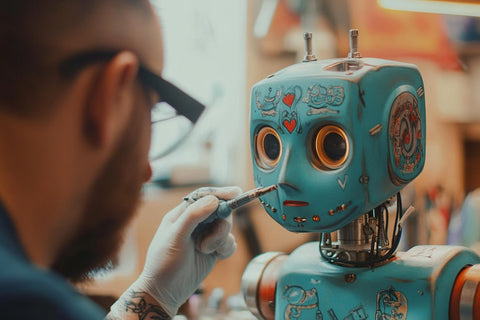Google recently unveiled a digital watermarking feature called SynthID, designed to subtly tag images generated or significantly edited by artificial intelligence. This innovative technology embeds an unseen identifier within the pixels of AI-produced images, remaining imperceptible to the human eye but detectable by software.
Unlike traditional watermarks that are often visible and can detract from the image's quality, Google's SynthID offers an invisible solution that preserves the original appearance and integrity of the photograph. The watermark is robust enough to withstand common edits such as cropping, filtering, or compressing. This ensures that an AI-generated image can still be recognized as artificial, even after alterations.
The initiative is part of Google's broader strategy to enhance transparency in AI technology. By identifying AI involvement in content creation, the company aims to improve trust online and combat misinformation, including deepfakes that manipulate images without obvious markers.
SynthID has begun rolling out across Google products, particularly within Google Photos' Magic Editor on Pixel devices. When users perform substantial edits—like adding or removing people or major objects—an invisible SynthID watermark is integrated into the final image. Minor adjustments may not trigger the watermark, ensuring that only significant edits are flagged.
Previously, Google had applied SynthID to images fully generated by its text-to-image model, Imagen, and is now extending it to edited photographs. This aligns with similar efforts from other tech firms and policymakers, all advocating for increased transparency amid growing concerns about deepfake technologies.
The technology behind SynthID, developed by Google's DeepMind team, works by making subtle alterations to pixel data, creating a unique digital signature that can be read by specialized detection tools but remains invisible to human observers. As this pattern is distributed throughout the image, even modifications like cropping or recoloring do not erase the identifier, ensuring persistent recognition of AI involvement.
Experts have generally welcomed Google's move for more transparency in AI-generated media. However, many caution that simply watermarking content doesn't address the broader challenge of ensuring authenticity. As Ken Sickles, a chief product officer at a digital watermarking company, points out, a malicious actor could easily use unregulated tools that don’t apply watermarks, allowing fraudulence to slip through the cracks.
Concerns about fragmentation arise as numerous companies aim to develop their watermarking solutions, creating an environment where no single standard dominates. Many tech firms are working on their own marking systems, making it challenging to ensure consistent identification across all forms of AI-generated media. Alternatives like C2PA (Coalition for Content Provenance and Authenticity) are also in the works, embedding cryptographic provenance data to provide additional authenticity measures.
Digital rights advocates express cautious optimism toward the transparency benefits of AI imagery labeling. However, they emphasize the importance of implementing these systems without infringing on privacy or free expression. Mandating watermarks can pose risks, particularly for artists or whistleblowers who may not want their work labeled or who require anonymity.
As industries navigate these developments, future regulations may require clearer disclosures of AI-generated content. Google currently advocates voluntary participation rather than regulatory intervention. Observers will be watching closely to see how well SynthID holds up in practice—its effectiveness against attempts to remove the watermark and whether users find it beneficial will be pivotal in shaping future iterations of the technology.
Overall, while SynthID is a promising step toward greater transparency in digital media, it represents just one piece of the puzzle. Incorporating additional verification methods will be crucial to combat deepfakes effectively and help ensure that viewers can trust the visuals they encounter online.
In a world increasingly driven by AI and automation, businesses are presented with unique opportunities, especially when it comes to content creation. This is where Motivo Media comes into play. We specialize in helping brands and small businesses leverage AI to streamline workflows and produce engaging content effortlessly. Whether you need captivating videos or written material, our team of AI content creation experts can elevate your brand's presence while saving you valuable time. Explore how we can assist you in automating your content needs by visiting AI content creation services at Motivo Media. Together, we can shape the future of your brand in this ever-evolving digital landscape.



